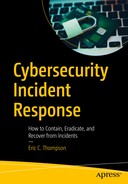Index
A, B
Breach
C
Command and control (C2)
Continuous monitoring
analyzing data
reporting
security controls
strategy
Culture
cybersecurity and incident response
leadership skills
team skills
technical skills
Cyber risks
activities
analysis
measurement
impact
likelihood
review
risk register
threat analysis
vulnerabilities
Cybersecurity functions
incident response support
Cybrary
D
Data loss prevention (DLP)
Data theft
Decisiveness
Denial of service (DoS)
E, F, G
Emotional intelligence
End point detection and response (EDR)
End users
Equifax
Event
Event and response phases
H
Humility
I, J
Incident
Incident handling
Incident response
containment
eradication and recovery
goals
identification
leadership
network segmentation
complexity, workload, and maintenance
corporate groups
infrastructure, New Product Development
vLANs
preplanning and strategy development
purpose
response
roles and responsibilities
triage
Indicators of compromise (IOCs)
Initial response team (IRT)
K
Kotter’s eight-step change model
communication
cybersecurity, information technology, and business teams
implementing change
incident response
investments
objectives
PowerShell script
short-term wins
strategic objectives
L
Leadership
continued learning and growth
decisiveness
emotional intelligence
hiring
humility
incident response teams
listening
Meyer’s formula
passion
skills
Lewin’s Change Management Model
change
phases
refreeze
unfreeze
Linux Event Logs
Listening
Log files
Lost assets
M
Malware
Mandiant’s Cyber Attack Life Cycle
phase one
establishing foothold
initial compromise
reconnaissance
phase three
phase two
internal recon
lateral moves
maintain presence
privilege escalation
purpose
Massachusetts Institute of Technology (MIT)
N
NetFlow
NIST 800-
adverse event
event
incident
NIST 800-137
NIST Cybersecurity Framework (CSF)
detect
anomalies and events
continuous monitoring
detection processes
identify
asset management
business environment
governance
risk assessment
risk management
supply chain risk management
protect
access control
awareness and training
data security
information protection
maintenance
Protective Technology
recover
communications
improvements
recovery planning
respond
analysis
communications
improvement
mitigation
response planning
O
Open Web Application Security Project (OWASP)
top-ten security risks
Organizational tiers
P, Q
Passion
Personally identifiable information (PII)
Phishing
Plan elements
Policy elements
Procedure elements
R
Ransomware
Locky Ransomware
Reconnaissance
Relationship management
Rootkit
S
Security incident and event management (SIEM)
Self-awareness
Self-management
Social awareness
Strategy
T
Tactics
TalentSmart
Team alignment
Team skills
Technical skills
U
Unauthorized access
V
Vulnerability scanning
W, X, Y, Z
Windows Event Logs
..................Content has been hidden....................
You can't read the all page of ebook, please click here login for view all page.
